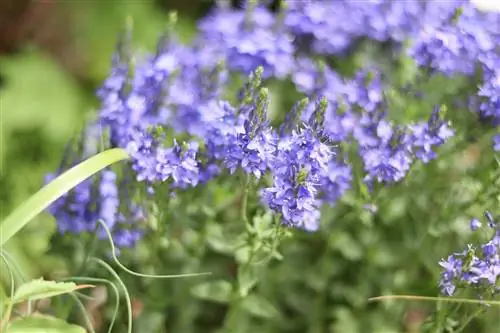- Author admin [email protected].
- Public 2023-12-17 03:39.
- Last modified 2025-06-01 06:48.
The speedwell (Veronica) is represented by around four hundred and fifty species worldwide. It used to belong to the figwort family, but has recently been assigned to the plantain family. In some cases it is also listed as a separate family of the speedwell plants (Veronicaceae).
Characteristics of the Speedwell'
Veronica grows as an annual to perennial herb. Almost all varieties overwinter with creeping rhizomes, which produce prostrate shoots of ten to twenty centimeters with ascending side branches and upright inflorescences in spring.
The leaves are arranged oppositely and are partly covered with stiff hairs. The flowers are in a racemose, very short-stemmed inflorescence that arises in the axil of the leaf and elongates slightly after flowering.
The individual flowers are located in the axil of a small bract on short, upright stems. The usually light purple, rarely white, four-pointed crown is composed of five fused crown leaves and forms a very short tube at the base.

In the period from June to August, the speedwell puts out countless of its violet flowers and can green up fallow areas within a short time.
Dissemination
The speedwell is spread across almost all of Europe and the Middle East. It is also considered native to North America. The true speedwell (V. officinalis) and the ivy-leaved speedwell (V. hederifolia) are less cultivated in the garden because they spread widely and are considered weeds.
Species such as the speedwell (V. spicata), which grows significantly higher and can reach a height of up to forty centimeters, as well as the heather speedwell (V.) are cultivated.dillenii), which stands out for its fleshy leaves and dark purple flowers, but only grows as an annual. However, both species are rarely found in the wild and have therefore been placed under species protection.
Cultivation
Veronica thrives in almost all soils. Various types of the plant can be found especially in lawns, in sandy heaths and pine forests as well as in fields. It prefers dry, lime-free soil in mostly open locations, although partially shaded locations are also favorable.

Ehrenpreis is particularly suitable for greening gaps or fallow areas. This is how he can
- in rock gardens,
- on sunny slopes and
- among conifers
be planted. However, it is not advisable to plant it near lawns as it spreads quickly and is difficult to remove from the lawn.
Annual species are planted in spring at a distance of about twenty centimeters. Perennial species can be planted in spring and summer and usually form dense carpets the following year. A number of species also sow themselves, so spreading them can sometimes be a nuisance. Above all, the soil should be well drained and contain few nutrients.
They are particularly suitable for cultivation in the garden as ground cover
- the thread speedwell (V. filiformis),
- the germander speedwell (V. chamaedrys),
- the Alpine Speedwell (V. alpina),
- the leafless speedwell (V. aphylla) and the
- Spike speedwell (V. spicata)
Honorary Award - Care

Ehrenpreis requires almost no care. Only annual species should be torn up and composted in autumn. The perennial species are usually hardy down to minus fifteen degrees Celsius, so they do not require winter protection. The plants move in after the growing season and sprout again in spring.
If wild species spread in the garden, this can be perceived as annoying. The ivy-leaved speedwell in particular tends to spread rapidly in the lawn and on beds. If this is the case, it should be meticulously removed by thoroughly pulling it out by the roots. This should be started in early spring, otherwise it will spread quickly through self-sowing.
For cultivated species in the garden, care should be taken to ensure sufficient water drainage. For this purpose, it can be helpful to mix gravel into the soil so that too much moisture does not cause the plants to rot.
Usage
The herb of speedwell contains bitter substances, tannins and essential oils. In the past, the herb was used in folk medicine as an expectorant agent for diseases of the respiratory system as well as for gout, rheumatism and diarrhea.






